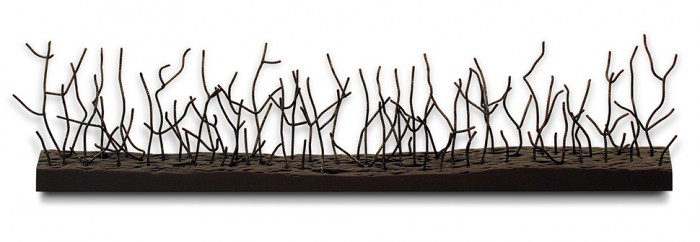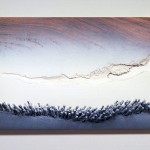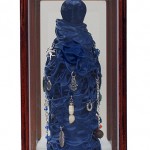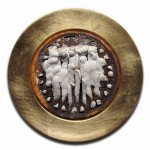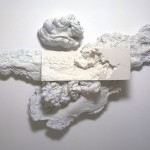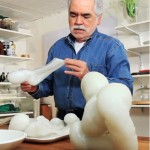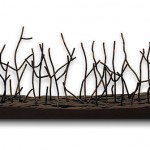Objetos de culto
Por Cocoa Life Style Miami
En los últimos años, algunos críticos de arte han comenzado a preguntarse sobre lo que es o no es Arte. Al observar su trayectoria y las diversas etapas de su obra, pensamos que su definición puede aportar luces al tema.
– La crítica de arte debe haber existido desde principios de la historia. Es según el criterio e intereses de cada crítico el determinar lo que puede considerarse “arte“, lo cual para mí es válido solamente como un ejercicio intelectual, por demás importante, pero es el espectador quien en definitiva tiene la última palabra para determinar que es arte para él y que no lo es. Eso para mí es la crítica más válida.
Lo que si es cierto es que el verdadero arte debe producir una reacción en el espectador. Debe proyectar emociones y conceptos novedosos, que excluyan todo aquello que copie o repita el pasado. Debe provocar, motivar, incentivar y captar la atención y el interés del espectador.
Háblenos brevemente de sus etapas y en especial de la actual en la cual trabaja y cómo la define.
-Comencé mi carrera a principios de los años sesenta exponiendo en diversos países de Latinoamérica mis dibujos sobre papel en blanco y negro, trataban sobre una “figura humana” como yo la imaginaba. En aquel período destacaba de mi trabajo la espontaneidad y la fuerza expresiva de mis trazos. Pero en 1975 sentí la necesidad de avanzar sobre el camino recorrido y, para no repetirme, propuse como tema el “paisaje” que fueron parte de invenciones técnicas más cercanas al collage y al ensamblaje que a la pintura. En los años 80 mis obras se salieron del muro para convertirse en objetos tridimensionales que realicé a manera de vegetaciones. Un buen día propuse éstas vegetaciones con frutos, para los que utilicé platos y bandejas como soporte.
Hacia los años 90 inventé una serie de “ofrendas alimenticias” que catalogué como “Objetos de culto”, los que a su vez me llevaron a reflexionar sobre la magia y las religiones. Como si se estuviera cerrando un círculo en mi trayectoria volví a interesarme en la figura humana, pero esta vez de manera diferente, a través de unos objetos que denomino “Shamanes” y “Fetiches”.
Háblenos de su trabajo y de la receptividad del público a sus obras
– Para mí constituye un momento de felicidad, el poder descubrir en los materiales sus universos de posibilidades, éstos me van sugiriendo a su vez los pasos a seguir. Si bien es cierto que mi manera de realizar las cosas no ha variado desde mis inicios como dibujante, cuando me expresaba a través de trazos, manchas y goteados, que es la manera mas libre y espontanea de expresión, la obra comienza a tomar cuerpo a medida que avanzo sobre esta, pero también podría agregar que lo que mas me complace es que sea el propio observador quien manifiesta sus emociones sobre lo que percibe de mi trabajo. Recuerdo que en una ocasión, en una feria de arte, confundido entre el público que observaba mis obras, me toco apreciar de cerca, a personas que se alegraban y reían observándolas, pero también a otras personas a quienes no les gustaban. Eso fue para mí el mayor signo de libertad de apreciación de cada quien, la mejor crítica que he recibido de mi trabajo.
Cual es su búsqueda en el terreno de la simbología.
-En la etapa actual de mi trabajo, que tiene como motivación el universo de las creencias, mi mayor interés radica en lo que genera la simbología en el ser humano. Me interesa plantear el porqué de este universo y como puede llegar a ser de tanta importancia para las personas, al punto de definir, en la mayoría de los casos, el norte de sus vidas.
¿Cómo concibió a los “Shamanes”?
-Comenzaron a aparecer poco después del año 2000. La idea me la brindaron mis “platos ofrenda” de aquel período, porque pensando en la razón de éstos y el porqué a través de la historia y en diferentes culturas el ser humano anhela que sus difuntos lleven consigo algo al más allá, comencé a trabajar sobre el tema de la magia, de lo ritual y de lo idolátrico. En el caso de los Shamanes, en el poder que muestran y proyectan.
Háblenos del premio que recibió recientemente.
-El “Premio Teodorico Quirós Alvarado” es el máximo galardón artístico que otorga Costa Rica a través del Museo de Arte Costarricense, a realizadores de las artes visuales de prolongada trayectoria.
En mi caso lo recibí con sorpresa y alegría, tomando en cuenta que no he vivido en Costa Rica desde hace muchos años, desde principios de la década del sesenta. Si bien es cierto que he expuesto allá en distintos museos, este premio me está invitando ahora a comenzar a dar a conocer a las nuevas generaciones de artistas costarricenses en qué consiste la investigación que me he propuesto a través de los años.
- «Wheat field» – 1995 – Mixed media on wood – 43 x 63 x 10 cm.
- « Shamán Nº1 », 2011, materiales diversos, 32,5 x17 x 17cm
- «O’culto N° 1» – 2008 – Mixed media – 5 x 33ø cm.
- «Germination II» – 1997 – Mixed media on polyethylene – 37x27x24 cm.
- «Clouds» – 1996 – Mixed media on wood – 43 x 67 x 10 cm.
- Carlos Poveda
- «Seedling» – 1997 – Mixed media on wood – 28 x 118 x 7 cm.
Carlos Poveda was born in 1940 in San Jose, Costa Rica. During the sixties he made several exhibitions throughout the Americas, where he obtained important prizes such as the VIII Sao Paulo Art Biennial, Brazil. In Costa Rica he was awarded with the National Prize for painting. In 2004 in Costa Rica he obtains the National Prize for Sculpture and in 2005 in Venezuela the Francisco Narvaez Prize at the VIII Francisco Narvaez Biennial for sculpture. This year he received the Teodorico Quirós Alvarado Prix, the most important award from the Costa Rica Fine Arts Museum. He lives and works in Paris.
OBJECTS OF WORSHIP
AN INTERVIEW TO CARLOS POVEDA
Cocoa Life Style Miami / April 2015
In recent years, some art critics have begun to wonder about what is or is not art. Watching your career and the various stages of your work, we think that your definition can bring light to the subject.
-Art criticism must have existed since the beginning of history. It is at the discretion and interests of each critic to determine what can be considered “art”, which to me is valid only as an intellectual exercise, it is very important but ultimately it is the viewer who has the final say in determining what is Art for him and what is not. That to me is the most valid critic.
What is certain is that true art should produce a reaction in the viewer. Art must project emotions and novel concepts, it has to exclude everything that copy or repeats the past. Should lead, motivate, encourage and capture the attention and interest of the viewer.
Tell us briefly about your stages in art and especially about the one you are at right now and how you define it.
– I started my career in the early sixties exhibiting in several Latin American countries my black and white drawings on paper, they where about “human form” as I imagined it. In that period I emphasized about my work the spontaneity and expressive strength of my strokes. But in 1975 I felt the necessity to move forward on the path in order not to repeat myself, I proposed as a theme the “landscape” that were part of technical inventions closest to the collage and assemblage techniques than to painting. In the 80’s my works escaped from the walls to become three-dimensional objects in the form of vegetation. One good day I proposed these vegetations with fruits, for which I used as support plates and trays.
Towards the 90’s I invented a series of “food offerings” which I cataloged as “Objects of Worship” which led me to reflect on magic and religion. As if I were closing a circle in my career I came to be interested in the human figure, but this time in a different way, through objects that I denominate “Shaman” and “Fetish”.
Tell us about your work and the receptivity of the public towards your works
-For me is a moment of happiness, to discover materials and their universe of possibilities, they suggest me the steps to follow. While it is true that my way of doing things has not changed since my beginnings as a drawer, when I expressed myself through strokes, ink stains and ink drops, which is the most freely and spontaneous form of expression, the work begins to take shape as I advance on it, but I could also add that what pleases me the most is that it is the observer himself who expresses his feelings about what he perceives in my work. I remember that in one occasion, during an art fair, camouflaged among the audience watching my works, I got to see up close people who were happy and laughing watching them, but also others who did not like them. That was for me the greatest sign of freedom, the best review I’ve ever received about my work.
What is your search in the field of symbolism.
-At this stage of my work, which is motivated by the universe of beliefs, my greatest interest is what generates the symbology in human beings. I’m interested in proposing the reason why of this universe and how it can become so important to people, to the point of defining, in most of cases, the north of their lives.
How did you conceive the “Shaman”?
-They began to appear shortly after the year 2000. The idea was given to me by my “offering dishes” from that period, because thinking about the reason why they were created and why through history and in several human cultures, the human being craves for the possibility of being able to allow their defuncts to take something with them to the world beyond life. I started working on the theme of magic, ritual and idolatrous. For Shamans, the power they show and project.
Tell us about the award that you recently received.
–The “Prize Teodorico Quirós Alvarado” is the highest artistic honor awarded by the Costa Rican Art Museum to visual arts artists with long careers.
In my case I received it with surprise and joy, considering that I have not lived in Costa Rica for many years, since the early 60’s. While I have exposed my art there, in diverse museums, this award is now inviting me to begin to inform the new generations of Costa Rican artists what is about the research that I have proposed through the years.
(*) Carlos Poveda was born in 1940 in San Jose, Costa Rica. During the sixties he made several exhibitions throughout the Americas, where he obtained important prizes such as the VIII Sao Paulo Art Biennial, Brazil. In Costa Rica he was awarded with the National Prize for painting. In 2004 in Costa Rica he obtains the National Prize for Sculpture and in 2005 in Venezuela the Francisco Narvaez Prize at the VIII Francisco Narvaez Biennial for sculpture. This year he received the Teodorico Quirós Alvarado Prix, the most important award from the Costa Rica Fine Arts Museum. He lives and works in Paris.






